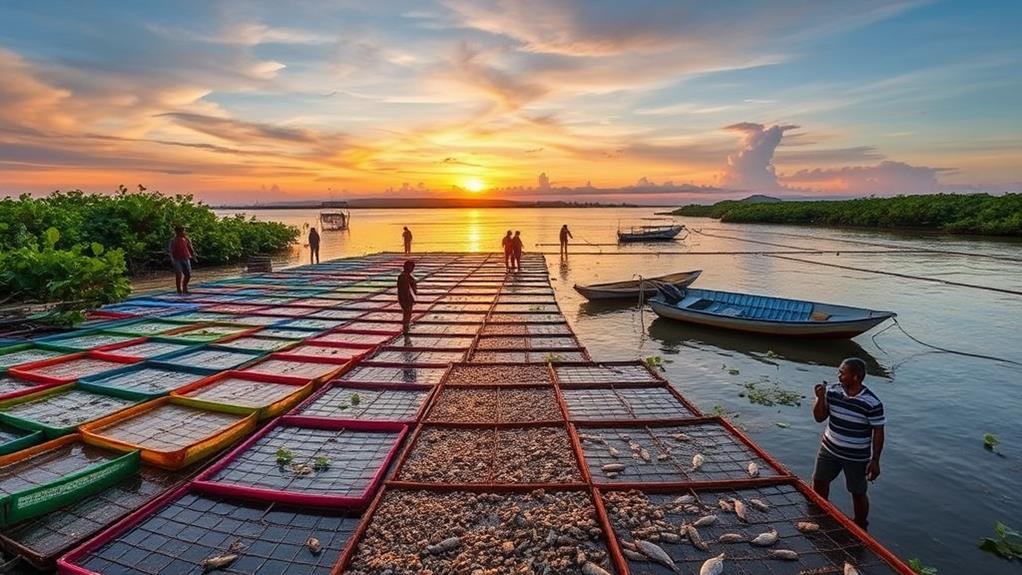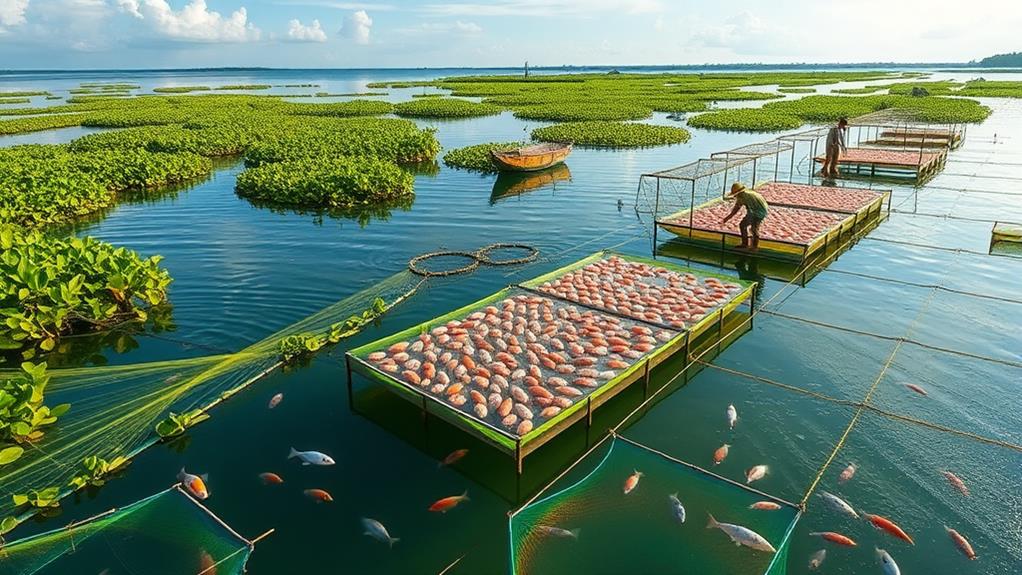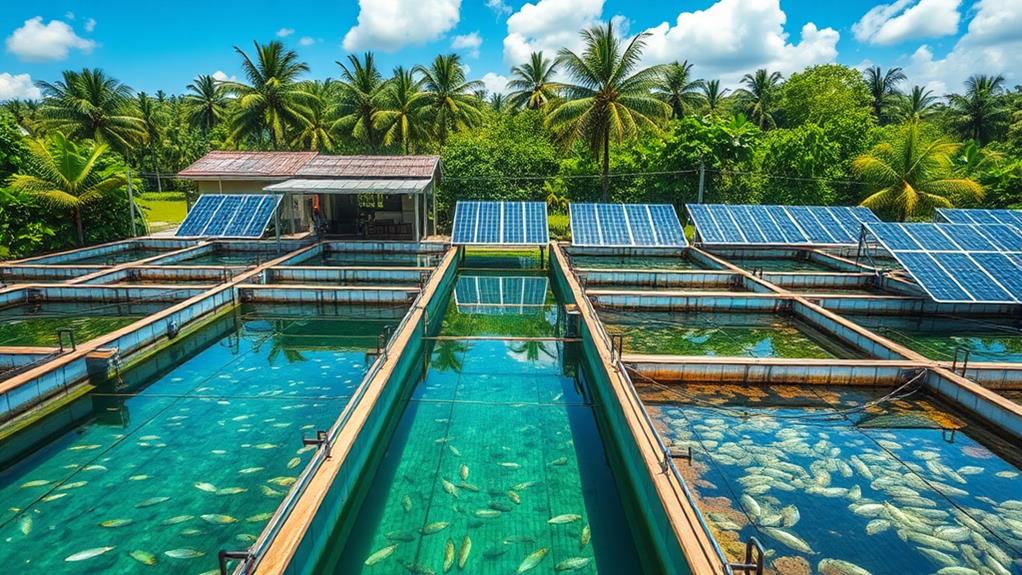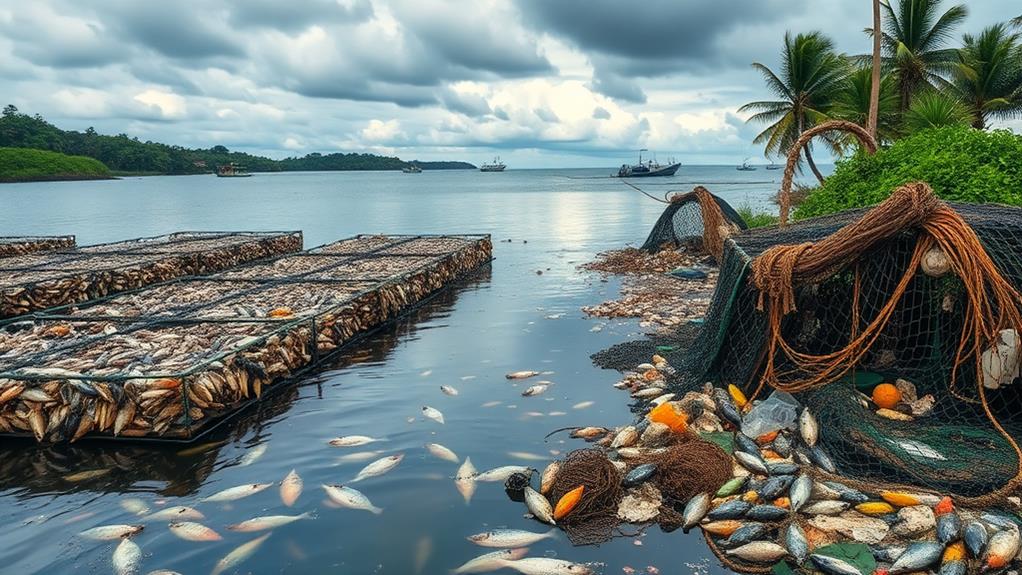Aquaculture in the Philippines is essential for increasing food production. It helps address the country's annual shortage of 1.4 million tons of food fish.
New methods like the In-Pond Raceway System and Biofloc Technology improve fish farming. These innovations boost efficiency and sustainability. For instance, the In-Pond Raceway System allows fish to grow faster in a controlled environment, while Biofloc Technology uses good bacteria to make fish feed more nutritious.
Collaboration among farmers, scientists, and businesses leads to better farming practices. This teamwork aligns with FAO guidelines for sustainability, which are important for long-term success.
However, challenges like disease and access to feed still exist. Despite these challenges, the innovations in aquaculture offer hope for a promising future in fish farming, ensuring food security and better management of resources.
There is much to learn in this important field.
Overview of Aquaculture in the Philippines

Aquaculture is very important in the Philippines, contributing 41% to the country's total fish production. This sector helps meet the food needs of the population.
However, it faces a shortage of about 1.4 million tons of food fish each year. To solve this problem, there's a focus on sustainable aquaculture practices. These practices aim to improve food security while protecting the environment.
The government and various groups are promoting sustainable fish farming. One example of a new technology is the In-Pond Raceway System (IPRS). This system helps improve efficiency and increase fish yields. It addresses the food supply issues and makes fish farming more economically viable.
Additionally, the Philippines has the highest annual shrimp growth rate in Southeast Asia, which is 12% from 2013 to 2020. This indicates a strong potential for expanding aquaculture in the country.
Innovations Enhancing Fish Farming
Innovative technologies are improving fish farming in the Philippines. The In-Pond Raceway System (IPRS) is a key example, allowing farmers to use the same water for multiple fish, which increases fish yield and lowers costs.
Another important development is ProEnk, a feed supplement made from fermented sweetpotato. It can replace 50% of soybean meal in fish diets, raising protein content significantly and improving fish survival rates.
Biofloc technology is also changing shrimp farming. It allows for production in nursery tanks, enabling 4-5 harvests per year, compared to just 3 in traditional ponds. This method enhances biosecurity and management.
The National Fisheries Research and Development Institute (NFRDI) is working on low-cost feed for milkfish and tilapia to help improve aquaculture and boost fisherfolk incomes.
Additionally, digital farming tools like AI and smart sensors are making aquaculture easier. Digital feeding systems and underwater drones collect important data and improve efficiency.
These innovations not only increase productivity but also support sustainable practices in fish farming.
Sustainable Practices in Aquaculture

Innovative technologies are making fish farming more sustainable in the Philippines. One example is the In-Pond Raceway System (IPRS), which allows farmers to use the same amount of water while producing more fish. This method lowers production costs and reduces risks, making fish farming easier to manage.
Another important development is the use of ProEnk, a fermented sweet potato product that can replace up to 50% of soybean meal in fish diets. This change not only enhances the protein content of the feed but also increases fish survival rates, leading to a more sustainable aquaculture system.
Additionally, biofloc technology helps in shrimp farming by integrating nursery phases, which raises the number of harvests each year. This method also improves biosecurity and reduces waste, protecting the environment.
The FAO Guidelines for Sustainable Aquaculture stress the need for environmental care and biodiversity protection. These guidelines help fight hunger and poverty through responsible fish farming.
Ongoing research and teamwork among farmers, scientists, and businesses are vital for developing new methods, such as microbial biomass fermentation and bioactive feed additives. These efforts support sustainable fish farming in the Philippines while maintaining ecological health.
Impact on Food Security
Food security in the Philippines is significantly affected by improvements in aquaculture. As of 2020, 59 million Filipinos faced food insecurity.
Aquaculture currently provides about 41% of the country's total fish supply, which is crucial for local nutrition. New systems like the In-Pond Raceway System (IPRS) help increase fish production while using less water, directly improving food security.
Additionally, using U.S. Soy as a feed helps control food prices and lowers production costs without compromising on quality.
Technologies such as Biofloc and alternative feeds like ProEnk increase production efficiency. These advancements make aquaculture more sustainable and help strengthen food security in the Philippines.
Technological Advancements in the Sector

Aquaculture in the Philippines is changing due to new technologies that improve how fish and shrimp are raised. These advancements help farmers produce more seafood while using fewer resources and protecting the environment.
| Technological Advancement | Benefits |
|---|---|
| In-Pond Raceway System (IPRS) | Increases fish yield without using more water, lowers costs. |
| Biofloc Technology | Allows 4-5 shrimp harvests per year, and helps control diseases. |
| ProEnk Fermentation | Replaces 50% of soybean meal, boosts protein content, and improves survival rates. |
Digital farming tools, like artificial intelligence (AI) and smart sensors, are now essential for managing aquaculture farms. Underwater drones collect important data that helps farmers make better decisions. The National Fisheries Research and Development Institute (NFRDI) is also creating affordable feeds and using biotechnology to promote sustainable practices.
These technologies not only increase production but also tackle key problems like water quality and disease management, which makes aquaculture more resilient for the future.
Collaborative Efforts and Partnerships
Collaborative efforts among industry stakeholders are essential for improving aquaculture in the Philippines. The Aquaculture Philippines and Livestock Philippines event, happening from May 22-24, 2024, will bring together over 250 exhibitors and 10,000 expected visitors. This event will help share knowledge and integrate new technologies into aquaculture practices.
The National Fisheries Research and Development Institute (NFRDI) supports programs that boost fisherfolk income. One example is the Technology Business Incubation (TBI) program, which encourages innovation and partnerships that can lead to economic growth.
The Bureau of Fisheries and Aquatic Resources also hosts seminars and workshops to improve aquaculture practices. These sessions promote the exchange of best practices among stakeholders.
International partnerships have introduced useful technologies to the Philippines. For instance, collaboration with U.S. soybean farmers has brought the In-Pond Raceway System (IPRS) to the region. This technology helps increase production efficiency and supports regional food security.
Overall, focused collaboration and research can lead to sustainable growth in the Philippine aquaculture sector.
How do Innovations in Aquaculture contribute to Sustainable Fisheries in the Philippines?
Innovations in aquaculture play a vital role in the importance of sustainable fisheries in the Philippines. By implementing advanced technology and practices, aquaculture helps in the conservation of marine resources and promotes responsible harvesting, ultimately contributing to the overall sustainability of the country’s fisheries.
Challenges Facing Aquaculture

Aquaculture in the Philippines faces serious challenges that affect its growth and sustainability. The country has a significant annual food fish shortage of about 1.4 million tons, which highlights the need for better aquaculture practices.
Here are three main challenges:
- Disease Prevention: Diseases in fish and shrimp can greatly reduce production. The shrimp sector has experienced many disease outbreaks, which not only lower current shrimp supplies but also threaten future growth.
- Poor Water Quality: Good water quality is essential for healthy fish. When water conditions worsen, it can lead to more diseases and unhealthy fish.
- Access to Low-Cost Feeds: Many fish farms struggle to find affordable feed, especially eel farms. About 40% of Filipino-owned farms find it hard to get enough feed, which is a major issue that needs solving.
To address these challenges, new technologies like Biofloc and ProEnk can help improve efficiency and make aquaculture more resilient.
Future Outlook for Fish Farming
The future of fish farming in the Philippines is bright due to new technologies and eco-friendly practices. One important advancement is the In-Pond Raceway System (IPRS), which helps increase fish production while lowering costs.
For example, IPRS allows fish to grow in a more controlled environment, leading to better use of space and resources.
Another innovation is biofloc technology, which enables farmers to harvest shrimp multiple times each year. This increases productivity and makes shrimp farming more sustainable.
Additionally, using fermented sweetpotato feed supplements like ProEnk can replace up to 50% of soybean meal in fish feed. This not only boosts protein content but also improves how well fish convert feed into growth.
Research into bioactive feed additives and fermentation processes is also vital for creating sustainable feed options, especially as the demand for protein in aquaculture grows.
Collaborative efforts, such as the Aquaculture Innovation and Investment Hub, are essential. They aim to build partnerships and attract investments to support sustainable fish farming.
Questions and Answers
What Is Fish Farming Aquaculture in the Philippines?
Fish farming, also known as aquaculture, is important in the Philippines. It helps grow local fish species, which supports food security in the country. For example, farmers raise tilapia and bangus (milkfish) to meet the demand for affordable protein.
Aquaculture also promotes environmental health. Farmers use sustainable practices, like rotating fish species and maintaining water quality, to protect local ecosystems. This helps ensure that fish farming is safe for the environment.
Innovations in fish farming, such as using technology for monitoring water conditions, make operations more efficient. These improvements not only increase fish production but also assist local communities. By providing jobs and income, fish farming supports families and strengthens the economy.
What Is the Current Status of Fisheries and Aquaculture in the Philippines?
The current status of fisheries and aquaculture in the Philippines is improving. Fisheries management has advanced, which helps in better regulating fish stocks. For example, rules on fishing seasons and quotas help prevent overfishing.
Aquaculture technology is also making progress. New methods, such as using better feeds and fish farming systems, increase the amount of fish produced. This is important because it helps meet the food security needs of many Filipinos who rely on fish as a main source of protein.
What Is the Future of Aquaculture in the Philippines?
The future of aquaculture in the Philippines relies on new technologies that improve efficiency and protect the environment. For example, smart farming techniques can help farmers monitor water quality and fish health, leading to better yields. Additionally, sustainable practices, like using feed made from plant sources instead of fish, can reduce the impact on wild fish populations. By focusing on these innovations, the aquaculture industry can continue to grow while being kind to nature.
What Is the Problem With Aquaculture in the Philippines?
Aquaculture in the Philippines has several major issues. Overfishing is a significant concern, as it reduces fish populations and affects local ecosystems. For example, too many fish are caught before they can reproduce, leading to fewer fish in the future.
Environmental impacts are also a problem. For instance, fish farms can pollute water and harm surrounding habitats. This can lead to loss of biodiversity, which is vital for healthy oceans and rivers.
Regulatory challenges make it hard to manage aquaculture effectively. There are often unclear laws or insufficient enforcement of existing regulations. This can result in illegal fishing practices that further harm fish stocks.
Disease management is critical in aquaculture. Fish farms can quickly spread diseases, which can wipe out entire populations. For example, a single outbreak can lead to significant losses for fish farmers.
Access to markets is another hurdle. Farmers may struggle to sell their products due to limited transportation or competition from imported fish. This can reduce their income and discourage sustainable practices.
Resource allocation is important too. Limited supplies of land and water can restrict the growth of aquaculture. For example, if too many farms are built in one area, it can lead to overuse of local resources.
Lastly, community involvement is essential. When local communities participate in aquaculture, they can help ensure practices are sustainable. However, if they are not included in decision-making, it can lead to conflicts and resistance.
Technological advancements are vital for improving aquaculture. New methods can help farmers raise fish more sustainably, reduce environmental impacts, and increase productivity.